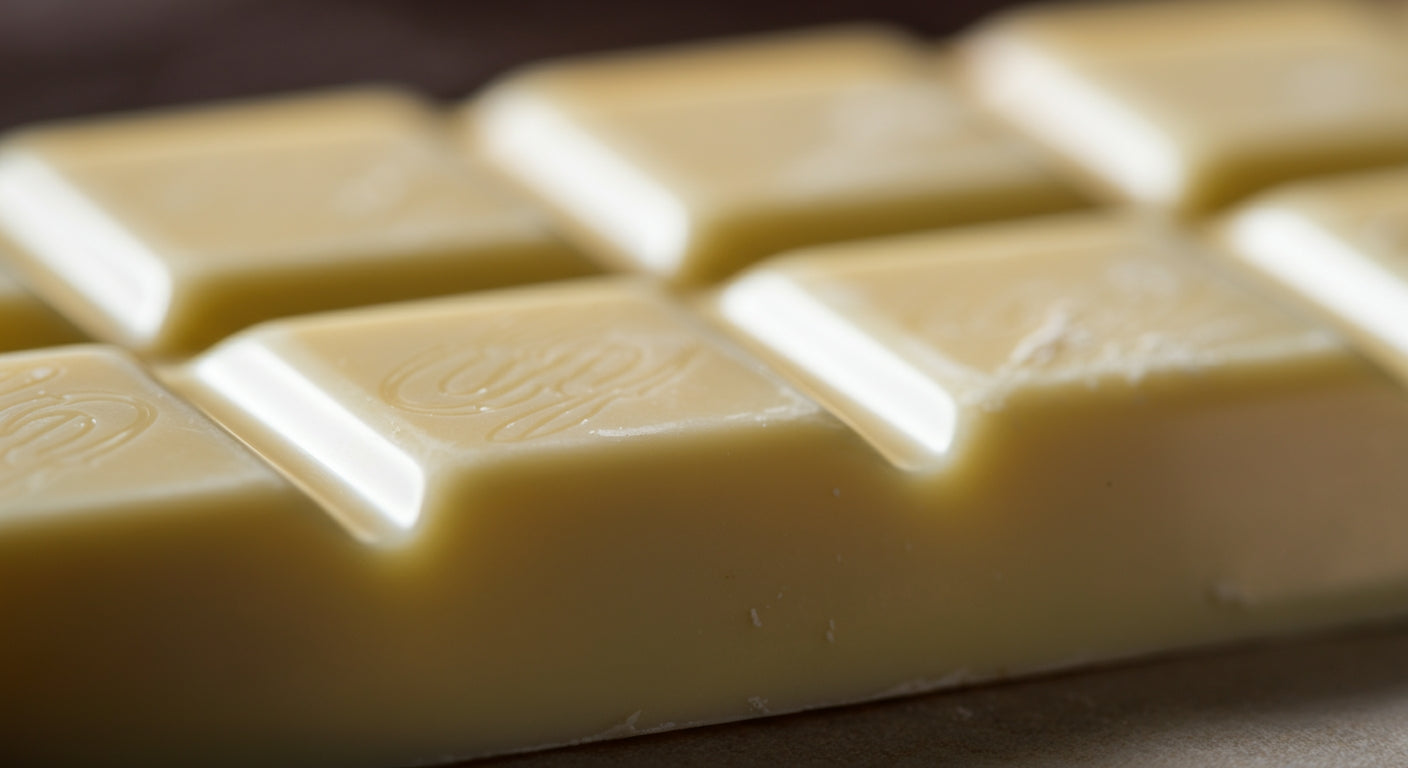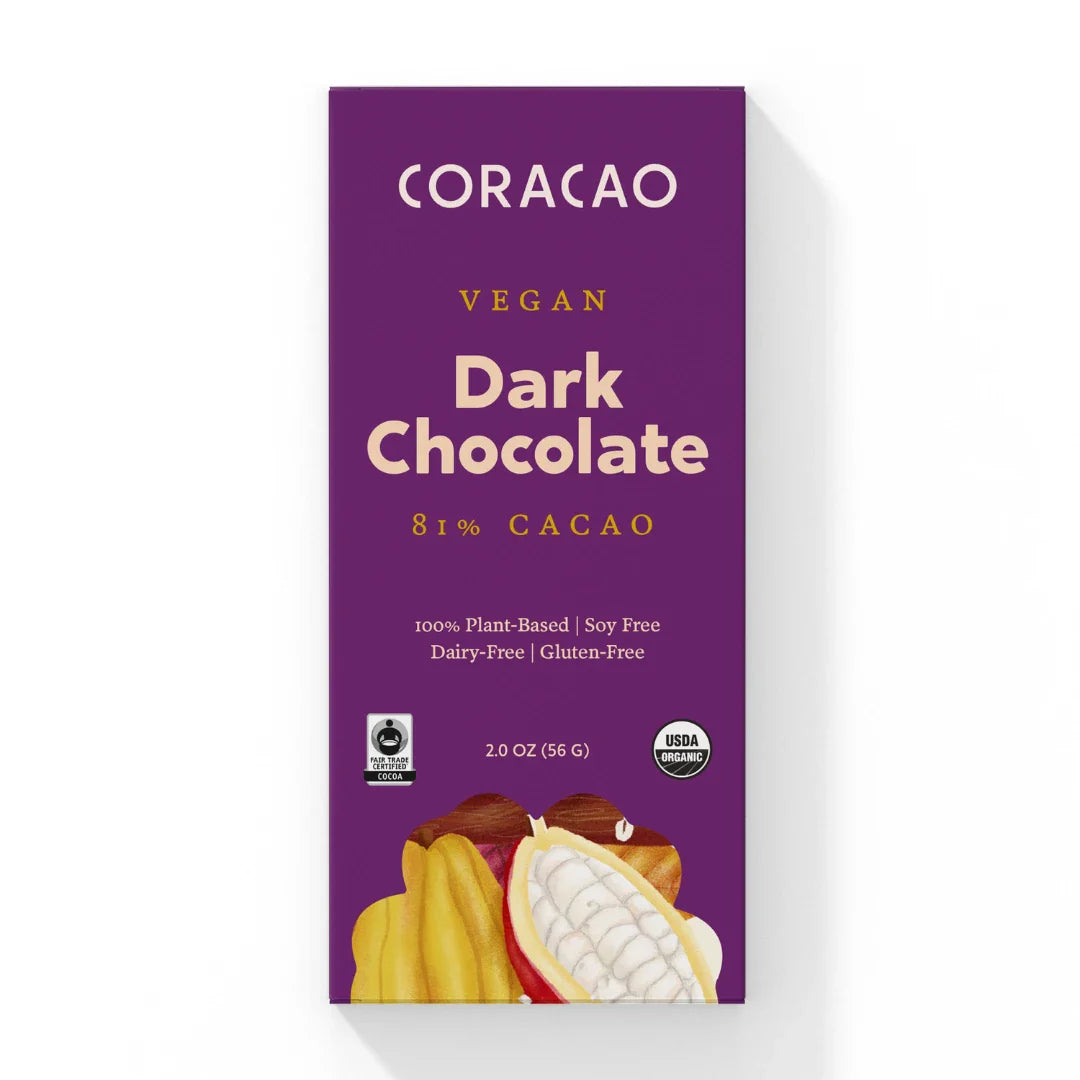
Is White Chocolate Vegan? Your Complete Guide to Plant-Based White Chocolate
If you're following a vegan lifestyle and craving the sweet, creamy taste of white chocolate, you need to know the facts. Traditional white chocolate is not vegan because it contains milk solids as a primary ingredient. However, innovative vegan white chocolate alternatives are now available that deliver the same creamy sweetness using plant-based ingredients. Understanding the difference between conventional and vegan white chocolate will help you make informed choices that align with your dietary values.
The Direct Answer: Traditional White Chocolate Is Not Vegan
What Makes White Chocolate Non-Vegan
Standard white chocolate contains:
- Milk solids or milk powder (20-25% of total content)
- Cacao butter (naturally vegan)
- Sugar (may be processed with bone char)
- Vanilla flavoring (usually plant-based)
- Lecithin (typically soy-based and vegan)
The milk solids are essential to traditional white chocolate's creamy texture and sweet flavor, making conventional white chocolate inherently non-vegan. Unlike dark chocolate, which can be made without any animal products, white chocolate's defining characteristic has historically been its dairy content.
Why Milk Is Used in White Chocolate
Functional Purposes:
- Texture: Creates the signature smooth, creamy mouthfeel
- Flavor: Provides mild, sweet taste without cacao's bitterness
- Color: Contributes to the characteristic white/ivory appearance
- Stability: Helps prevent bloom and extends shelf life
Manufacturing Convenience:
- Established Processes: Traditional recipes and equipment designed around dairy
- Consumer Expectations: Familiar taste profile most people expect
- Cost Considerations: Milk powder is often less expensive than alternatives
Understanding Vegan White Chocolate Alternatives
How Vegan White Chocolate Is Made
Plant-Based Ingredients:
- Cacao butter (the vegan base - naturally dairy-free)
- Plant milk powders (coconut, rice, oat, or cashew)
- Natural sweeteners (coconut sugar, rice syrup, or organic cane sugar)
- Vanilla extract (plant-based)
- Natural thickeners (coconut cream, cashew cream)
Our cacao butter provides the perfect foundation for creating vegan white chocolate, offering the same smooth melting properties as traditional versions while remaining completely plant-based.
Texture and Flavor Differences
Vegan White Chocolate Characteristics:
- Slightly different mouthfeel: May be less creamy initially but melts similarly
- Unique flavor notes: Coconut or nut undertones depending on base ingredients
- Natural sweetness: Often less artificially sweet than dairy versions
- Clean finish: No dairy aftertaste
Quality Variations:
- Premium versions: Use high-quality cacao butter and natural ingredients
- Budget options: May use more fillers and artificial flavors
- Artisanal varieties: Often feature unique flavor combinations

Ingredients to Avoid in White Chocolate
Obvious Non-Vegan Ingredients
Dairy-Based Components:
- Milk solids, milk powder, dry milk
- Whey protein, whey powder
- Casein, sodium caseinate
- Lactose, milk sugar
- Butter, milk fat
- Cream, dried cream
Other Animal Products:
- Honey (used as sweetener in some artisanal varieties)
- Shellac (confectioner's glaze from lac beetles)
- Carmine (red coloring, rarely used in white chocolate but possible)
Hidden Non-Vegan Ingredients
Ambiguous Terms:
- "Natural flavors": May contain dairy-derived compounds
- Vitamin D3: Often derived from sheep's wool (lanolin)
- Some emulsifiers: Potentially animal-derived
- Certain sugars: Processed with bone char from animals
Processing Concerns:
- Shared equipment: Cross-contamination with dairy chocolate
- "May contain milk" warnings on packaging
- Facility contamination: Airborne dairy particles
How to Identify Vegan White Chocolate
Positive Indicators to Look For
Certification Labels:
- Vegan Society logo
- Certified Vegan symbol
- Plant-Based certification
- Dairy-free verification
Ingredient Transparency:
- Simple, recognizable ingredients
- Clearly labeled plant milk sources
- Organic certifications (often indicate cleaner processing)
- Fair-trade markings
Label Reading Strategy
First Check: Look for vegan certification symbols Ingredient Scan: Verify no milk-derived ingredients Allergen Warnings: Avoid "may contain milk" statements Manufacturing Info: Seek dedicated vegan facility processing
Red Flags:
- Vague ingredient lists
- Multiple "natural flavors" without specification
- No clear dairy-free claims
- Extremely low prices (quality ingredients cost more)
DIY Vegan White Chocolate Using Cacao Butter
Basic Homemade Recipe
Ingredients:
- 1/2 cup organic cacao butter, melted
- 1/4 cup coconut milk powder
- 1/4 cup powdered coconut sugar
- 1 teaspoon vanilla extract
- Pinch of sea salt
Method:
- Gently melt cacao butter (keep below 118°F for raw version)
- Whisk in coconut milk powder until smooth
- Add sweetener, vanilla, and salt
- Pour into molds and refrigerate until set
- Store in cool, dry place
Advanced Flavor Variations
Coconut White Chocolate: Extra coconut cream for tropical flavor Cashew White Chocolate: Cashew cream for ultra-smooth texture Vanilla Bean: Real vanilla beans for gourmet flavor Lavender White: Food-grade lavender for unique sophistication
Learn more about working with cacao butter to create professional-quality homemade chocolates.
Equipment and Tips
Essential Tools:
- Double boiler or low-heat melting setup
- Silicone chocolate molds
- Fine-mesh strainer for smooth texture
- Thermometer for temperature control
Pro Tips:
- Temperature Control: Overheating can cause separation
- Gradual Mixing: Add powders slowly to prevent lumps
- Proper Storage: Keep finished chocolate cool and dry
- Quality Ingredients: Premium cacao butter makes all the difference

Health Considerations: Vegan vs. Traditional White Chocolate
Nutritional Differences
Vegan White Chocolate Benefits:
- No cholesterol (plant-based fats only)
- Lactose-free (easier digestion for many people)
- Often less processed (especially artisanal versions)
- Potential for added nutrients (from nut or coconut bases)
Potential Drawbacks:
- Higher calorie density in some coconut-based versions
- Different mineral profile (no calcium from dairy)
- Possible allergens (tree nuts, coconut)
- Variable quality depending on manufacturer
Digestive Benefits
For Lactose-Intolerant Individuals:
- No digestive distress from dairy sugars
- Better nutrient absorption without dairy interference
- Reduced inflammation for those sensitive to dairy
- Comfortable enjoyment without health concerns
Understanding cacao butter's health benefits helps you appreciate why it's an excellent base for healthy white chocolate alternatives.
Popular Vegan White Chocolate Brands and Options
What to Look For in Commercial Versions
Quality Indicators:
- High cacao butter content (first ingredient)
- Minimal processing (shorter ingredient lists)
- Organic certification (cleaner ingredients and processing)
- Fair-trade sourcing (ethical ingredient procurement)
Texture Expectations:
- Smooth melting (should melt cleanly on tongue)
- No grittiness (properly processed ingredients)
- Good snap (quality cacao butter provides structure)
- Clean finish (no artificial aftertaste)
Price Considerations
Premium Vegan White Chocolate:
- Higher initial cost due to quality ingredients
- Better satisfaction per serving
- Often organic and fair-trade
- Superior taste and texture
Budget-Friendly Options:
- Store brands with simple ingredients
- Bulk purchasing for regular consumption
- DIY production using our cacao butter
- Seasonal sales and promotions
Culinary Applications for Vegan White Chocolate
Baking and Confections
Popular Uses:
- White chocolate chips for cookies and muffins
- Ganache using plant-based cream
- Coatings for truffles and bonbons
- Decorative drizzles for cakes and desserts
Recipe Adaptations:
- Melting properties may differ slightly from dairy versions
- Sweetness levels might need adjustment
- Texture modifications in some applications
- Temperature sensitivity during processing
Beverage Applications
Hot White Chocolate: Using plant-based milk and vegan white chocolate Iced Drinks: Summer beverages with coconut milk base Coffee Additions: White chocolate flavoring for plant-based lattes Smoothie Boosts: Adding creamy sweetness to fruit smoothies
Creative Flavor Pairings
Complementary Flavors:
- Raspberry and rose for elegant combinations
- Lemon and lavender for sophisticated treats
- Coconut and lime for tropical themes
- Vanilla and cardamom for warm spice notes

Storage and Handling of Vegan White Chocolate
Optimal Storage Conditions
Environmental Factors:
- Temperature: Cool, consistent (60-68°F ideal)
- Humidity: Low moisture environment
- Light: Dark storage to prevent degradation
- Air: Airtight containers to prevent oxidation
Packaging Considerations:
- Original wrapping until ready to use
- Food-safe containers for opened products
- Separation from strong-smelling foods
- Portion control to minimize exposure
Bloom Prevention
White Bloom Causes:
- Temperature fluctuations causing fat migration
- Humidity exposure creating sugar crystals
- Poor storage conditions
- Age and ingredient separation
Prevention Strategies:
- Consistent temperature storage
- Proper wrapping to prevent moisture
- Quality ingredients that resist separation
- Rotation system using oldest products first
The Environmental Impact of Vegan White Chocolate
Sustainability Benefits
Environmental Advantages:
- Lower carbon footprint (no dairy industry impact)
- Reduced water usage (dairy farming is water-intensive)
- Less land use (no pasture requirements)
- Biodiversity support (sustainable cacao farming)
Ethical Considerations
Animal Welfare: No animal exploitation in production Fair Trade: Our commitment to ethical sourcing supports farmer communities Worker Rights: Supporting fair labor practices in cacao production Community Development: Fair wages improve farming communities
Troubleshooting Vegan White Chocolate Issues
Common Problems and Solutions
Problem: Grainy Texture
- Cause: Insufficient mixing or low-quality ingredients
- Solution: Better blending, higher-quality cacao butter
Problem: Won't Set Properly
- Cause: Temperature issues or ingredient ratios
- Solution: Proper cooling, adjust cacao butter content
Problem: Strange Aftertaste
- Cause: Poor-quality ingredients or processing
- Solution: Source premium ingredients, check freshness
Problem: Doesn't Melt Smoothly
- Cause: Improper ingredient balance
- Solution: Adjust ratios, ensure quality cacao butter base
Future of Vegan White Chocolate
Innovation Trends
Ingredient Development:
- New plant milk powders for improved texture
- Alternative sweeteners for health-conscious consumers
- Functional additions (probiotics, adaptogens)
- Sustainable packaging solutions
Market Growth:
- Increasing demand from plant-based consumers
- Mainstream acceptance in traditional markets
- Premium positioning as artisanal option
- Technology improvements in processing methods
Our ongoing innovation in plant-based chocolate alternatives keeps us at the forefront of vegan chocolate development.
Frequently Asked Questions
Can I substitute vegan white chocolate for regular white chocolate in recipes?
Generally yes, but expect slight differences in melting properties and sweetness levels. Using high-quality cacao butter as a base ensures better results that closely mimic traditional white chocolate behavior in recipes.
Why is vegan white chocolate often more expensive than regular white chocolate?
Premium plant-based ingredients, smaller production runs, and specialized processing typically cost more than mass-produced dairy versions. However, the price gap is narrowing as demand increases and production scales up.
Does vegan white chocolate taste the same as traditional white chocolate?
While similar, vegan versions often have subtle flavor differences depending on the plant milk base used. Many people find high-quality vegan white chocolate equally satisfying and sometimes prefer the cleaner taste without dairy.
Is coconut-based white chocolate safe for people with tree nut allergies?
Coconut is technically classified as a tree nut by the FDA, though it's botanically a fruit. People with tree nut allergies should consult their healthcare providers and may need to choose rice or oat-based alternatives instead.
How long does homemade vegan white chocolate last?
When stored properly in cool, dry conditions, homemade vegan white chocolate using quality cacao butter typically lasts 2-3 months. Commercial versions may last longer due to stabilizers and preservatives.
Can I make vegan white chocolate without cacao butter?
While possible using coconut oil or other plant fats, cacao butter provides the best texture, melting properties, and flavor. Pure cacao butter is essential for achieving authentic white chocolate characteristics.
Quick Vegan Guide (Featured Snippet Optimized)
Traditional white chocolate is not vegan due to milk solids. Vegan alternatives use cacao butter, plant milk powders (coconut, cashew, rice), and natural sweeteners. Look for vegan certification, avoid "may contain milk" warnings. DIY options using cacao butter create quality homemade versions. Commercial vegan white chocolate is increasingly available.
Satisfy Your White Chocolate Cravings Ethically
Understanding that traditional white chocolate isn't vegan opens the door to discovering innovative plant-based alternatives that don't compromise on taste or texture. While conventional white chocolate relies on dairy for its signature characteristics, modern vegan versions prove that plant-based ingredients can create equally satisfying experiences.
Our premium cacao butter provides the perfect foundation for creating your own vegan white chocolate masterpieces, whether you're making simple treats at home or developing complex confections. The smooth melting properties and neutral flavor make it ideal for capturing the essence of white chocolate without any animal products.
As the plant-based movement continues growing, vegan white chocolate options will only improve and become more accessible. Explore our complete collection of ethically-sourced cacao products to support your plant-based chocolate journey, from organic cacao powder for diverse applications to premium chocolate bars that demonstrate the possibilities of pure, plant-based indulgence.
Learn more about plant-based chocolate innovations through our comprehensive blog, where we share insights about vegan chocolate development, traditional techniques adapted for modern plant-based lifestyles, and the art of creating extraordinary chocolate experiences that honor both your values and your taste preferences.

Claire Bennett
I'm Claire, a chocolate lover and artisan based in a small town where I run a tiny home kitchen dedicated to exploring everything chocolate. From single-origin dark bars to creamy ganache and handmade truffles, I find joy in working with all types of chocolate. I believe chocolate has a story, and I love bringing that story to life through humble, heartfelt creations.



Leave a comment
This site is protected by hCaptcha and the hCaptcha Privacy Policy and Terms of Service apply.